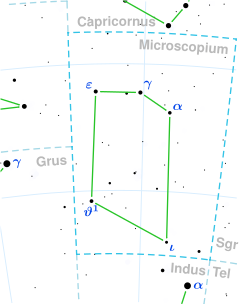| Observation data Epoch J2000.0 Equinox J2000.0 (ICRS) | |
|---|---|
| Constellation | Microscopium |
| Right ascension | 21h 02m 27.16546s[1] |
| Declination | −38° 31′ 51.4904″[1] |
| Apparent magnitude (V) | 5.94[2] |
| Characteristics | |
| Evolutionary stage | red giant branch[3] |
| Spectral type | K2 III[4] or K0 IV[5] |
| B−V color index | +1.15[2] |
| Astrometry | |
| Radial velocity (Rv) | 39±10[6] km/s |
| Proper motion (μ) | RA: +156.842 mas/yr[1] Dec.: −171.108 mas/yr[1] |
| Parallax (π) | 14.358 ± 0.0466 mas[1] |
| Distance | 227.2 ± 0.7 ly (69.6 ± 0.2 pc) |
| Absolute magnitude (MV) | +1.79[7] |
| Details | |
| Mass | 1.03[8] M☉ |
| Radius | 9.15±0.46[9] R☉ |
| Luminosity | 28.8±0.3[1] L☉ |
| Surface gravity (log g) | 2.75[8] cgs |
| Temperature | 4,569±50[10] K |
| Metallicity [Fe/H] | −0.13[8] dex |
| Rotational velocity (v sin i) | 2.7±1.1[11] km/s |
| Age | 8.79+2.32 −2.04[12] Gyr |
| Other designations | |
| Database references | |
| SIMBAD | data |
HD 200073 (HR 8046; 43 G. Microscopii) is a solitary star located in the southern constellation Microscopium 8.5′ northwest of Zeta Microscopii. It is faintly visible to the naked eye as an orange-hued point of light with an apparent magnitude of 5.94.[2] The object is located relatively close at a distance of 227 light-years based on Gaia DR3 parallax measurements, but it is receding with a heliocentric radial velocity of 39 km/s.[6] At its current distance, HD 200073's brightness is diminished by an interstellar extinction of 0.13 magnitudes[15] and it has an absolute magnitude of +1.79.[7] It has a relatively high proper motion across the celestial sphere, moving at a rate of 213 mas/yr.[1]
HD 200073 has a stellar classification of K2 III,[4] indicating that it is an evolved K-type giant that has exhausted hydrogen at its core and left the main sequence. Astronomer David Stanley Evans gave a class of K0 IV,[5] indicating that it is a slightly evolved subgiant that is ceasing hydrogen fusion at its core. HD 200073 is currently on the red giant branch,[3] fusing hydrogen in a shell around an inert helium core. It has a comparable mass to the Sun[8] but at the age of 8.79 billion years,[12] it has expanded to 9.15 times the radius of the Sun.[9] It radiates 28.8 times the luminosity of the Sun[1] from its enlarged photosphere at an effective temperature of 4,569 K.[10] HD 200073 is slightly metal-deficient with an iron abundance of [Fe/H] = −0.13 or 74.1% of the Sun's.[8] It spins modestly with a projected rotational velocity of 2.7 km/s.[11]
- ^ a b c d e f g Cite error: The named reference
GaiaDR3was invoked but never defined (see the help page). - ^ a b c Cite error: The named reference
Johnson1966was invoked but never defined (see the help page). - ^ a b Cite error: The named reference
Jones2011was invoked but never defined (see the help page). - ^ a b Cite error: The named reference
Houk1982was invoked but never defined (see the help page). - ^ a b Cite error: The named reference
Evans1964was invoked but never defined (see the help page). - ^ a b Cite error: The named reference
Kharchenko2007was invoked but never defined (see the help page). - ^ a b Cite error: The named reference
Anderson2012was invoked but never defined (see the help page). - ^ a b c d e Cite error: The named reference
Wittenmyer2016was invoked but never defined (see the help page). - ^ a b Cite error: The named reference
Kervella2004was invoked but never defined (see the help page). - ^ a b Cite error: The named reference
Stassun2019was invoked but never defined (see the help page). - ^ a b Cite error: The named reference
De Medeiros2014was invoked but never defined (see the help page). - ^ a b Cite error: The named reference
Soto2021was invoked but never defined (see the help page). - ^ Cite error: The named reference
Gould1879was invoked but never defined (see the help page). - ^ Cite error: The named reference
SiMBADwas invoked but never defined (see the help page). - ^ Cite error: The named reference
Gontcharov2017was invoked but never defined (see the help page).
